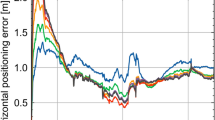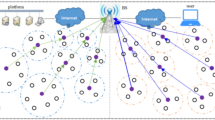Abstract
With the rapid development of network technology, more and more people attach importance to location-based services, which promotes the rapid development of positioning technology, especially indoor positioning technology. WiFi features of low cost and wide coverage based on received signal strength indication (RSSI) is an ideal positioning method. However, the traditional fingerprinting positioning method has a high calculation amount and does not consider the problem of different access points (APs) impacting in different directions. A fingerprint positioning method based on Quadtree Search and Fractal Direction Entropy Weighting is proposed. In QSFDEW, the quadtree algorithm is used to divide the two-dimensional plane of the location area, and the fingerprint data is stored in the form of a grid. At the stage of online positioning, it is transformed into quadtree search, which quickly searches the adjacent quadrants and selects the corresponding nearest neighbor reference points at the bottom of the search, and then combines the idea of entropy weighting for positioning. Compared with other algorithms, the biggest feature of QSFDEW is its low complexity and high localization efficiency. Our experiment shows that QSFDEW has better positioning results than the traditional fingerprinting positioning method.










Similar content being viewed by others
References
Liu, F., et al. (2020). Survey on WiFi-based indoor positioning techniques. IET Communications, 14(9), 1372–1383.
Montesano, A. et al., (2007). Galileo system navigation antenna for global positioning. In 2nd European Conference on Antennas and Propagation, (EuCAP’07) (pp. 1–6).
Li, X., Zhang, X., Ren, X., et al. (2015). Precise positioning with current multi-constellation global navigation satellite systems: GPS, GLONASS, Galileo and BeiDou. Scientific reports, 5, 8328.
Global Positioning System: Theory and Applications. (1966). Volume I. American Institute of Aeronautics and Astronautics
Priyantha, N. B., Chakraborty, A., Balakrishnan, H. (2000). The cricket location-support system. In Proceedings of the 6th Annual International Conference on Mobile Computing and Networking, (vol. 2000, pp. 32–43).
Comuniello, A., De Angelis, A., Moschitta, A. (2020). A low-cost TDoA-based ultrasonic positioning system. In 2020 IEEE International Instrumentation and Measurement Technology Conference (I2MTC) (pp. 1–6).
Marzec, P., Kos, A. (2020). Indoor precise infrared navigation. In: 2020 27th International Conference on Mixed Design of Integrated Circuits and System (MIXDES) (pp. 249–254).
Long, T. D., Suh, Y. S. (2012). Person location estimation using an inertial sensor unit and wireless modules. In 2012 12th International Conference on Control, Automation and Systems (pp. 1271–1274).
Dong, J., Noreikis, M., Xiao, Y., & Ylä-Jääski, A. (2018). ViNav: A vision-based indoor navigation system for smartphones. IEEE Transactions on Mobile Computing, 18(6), 1461–1475.
Luo, H., et al. (2018). Research on an adaptive algorithm for indoor bluetooth positioning. International Journal of Pattern Recognition and Artificial Intelligence, 32(06), 1854014.
Zhou, Q., et al. (2019). Unmanned patrol system based on kalman filter and ZigBee positioning technology. Journal of Physics: Conference Series, 1168(3), 032063–032063.
Zhai, W. (2018). A new positioning system based on radio frequency identification and neighbourhood positioning algorithm. International Journal of RF Technologies, 9(3–4), 89–99.
Schroeer, G. (2018). A Real-Time UWB multi-channel indoor positioning system for industrial scenarios. International Conference on Indoor Positioning and Indoor Navigation (IPIN), 2018, 1–5.
Joseph, R., & Sasi, S. B. (2018). Indoor positioning using WiFi fingerprint. International Conference on Circuits and Systems in Digital Enterprise Technology (ICCSDET), 2018, 1–3.
Guenther Retscher and Jonathan Kleine and Lisa Whitemore. (2019). Trilateration approaches for indoor Wi-Fi positioning. In E3S Web of Conferences (vol. 94, pp. 02002).
Kasebzadeh, P., Granados G. S., Lohan E. S. (2014). Indoor localization via wlan path-loss models and dempster-shafer combining. In Proceedings of the International Conference on Localization and GNSS (pp. 1–6).
Youssef, M., & Agrawala, A. (2004). Handling samples correlation in the Horus system. Proceedings IEEE Infocom, 2, 1023–1031.
Xie Shicheng, Yu., Xuexiang, Z. J., et al. (2021). An improved WIFI location fingerprint indoor positioning algorithm. Journal of Hefei University of Technology (Natural Science), 44(6), 753–757.
Chaoan, L., & Piao, L. (2021). Indoor localization method based on gaussian process regression and WiFi fingerprint. Journal of Electronic Measurement and Instrumentation, 35(2), 186–193.
Ko, D., Kim, M., Son, K., & Han, D. (2022). Passive Fingerprinting reinforced by active radiomap for WLAN indoor positioning system. IEEE Sensors Journal, 22(6), 5238–5247.
Ye, H., & Peng, J. (2022). Robot indoor positioning and navigation based on improved WiFi location fingerprint positioning algorithm. Wireless Communications and Mobile Computing, 2022, 13.
Alhammadi, A., Alraih, S., Hashim, F., Rasid, M. F. A. (2019). Robust 3D indoor positioning system based on radio map using Bayesian network. In 2019 IEEE 5th World Forum on Internet of Things (WF-IoT).
Malik, R. F., et al. (2019). WLAN based position estimation system using classification fuzzy K-nearest neighbor. Earth Environmental Science, 15, 1–12.
Ge, X., Qu, Z. (2016). WIFI indoor positioning KNN algorithm location based fingerprint. In IEEE International Conference on Software Engineering and Service Science.
Li, C., & Qiu, Z. (2017). An improved weighted KNN algorithm for indoor positioning. Springer Nature, 96(2), 2239–2252.
Zhang, H., Wang, Z., Xia, W., Ni, Y., & Zhao, H. (2022). Weighted adaptive KNN algorithm with historical information fusion for fingerprint positioning. IEEE Wireless Communications Letters, 11(5), 1002–1006.
Tao, Y., & Zhao, L. (2022). AIPS: An accurate indoor positioning system with fingerprint map adaptation. IEEE Internet of Things Journal, 9(4), 3062–3073.
Fang, S. H., Lin, T. N. (2010). Accurate indoor location estimation by incorporating the importance of access points in wireless local area networks. In Proceedings of the Global Telecommunications Conference (pp. 1–5).
Acknowledgements
This work was partially supported by National Natural Science Foundation of China under Grant (No. 61973055), and Fundamental Research Funds for the Central Universities (No. ZYGX2020J011).
Author information
Authors and Affiliations
Corresponding author
Additional information
Publisher's Note
Springer Nature remains neutral with regard to jurisdictional claims in published maps and institutional affiliations.
Supplementary Information
Below is the link to the electronic supplementary material.
Rights and permissions
Springer Nature or its licensor holds exclusive rights to this article under a publishing agreement with the author(s) or other rightsholder(s); author self-archiving of the accepted manuscript version of this article is solely governed by the terms of such publishing agreement and applicable law.
About this article
Cite this article
Huang, Y., Ye, R., Yan, B. et al. QSFDEW: a fingerprint positioning method based on quadtree search and fractal direction entropy weighting. Wireless Netw 29, 437–448 (2023). https://doi.org/10.1007/s11276-022-03147-x
Accepted:
Published:
Issue Date:
DOI: https://doi.org/10.1007/s11276-022-03147-x




